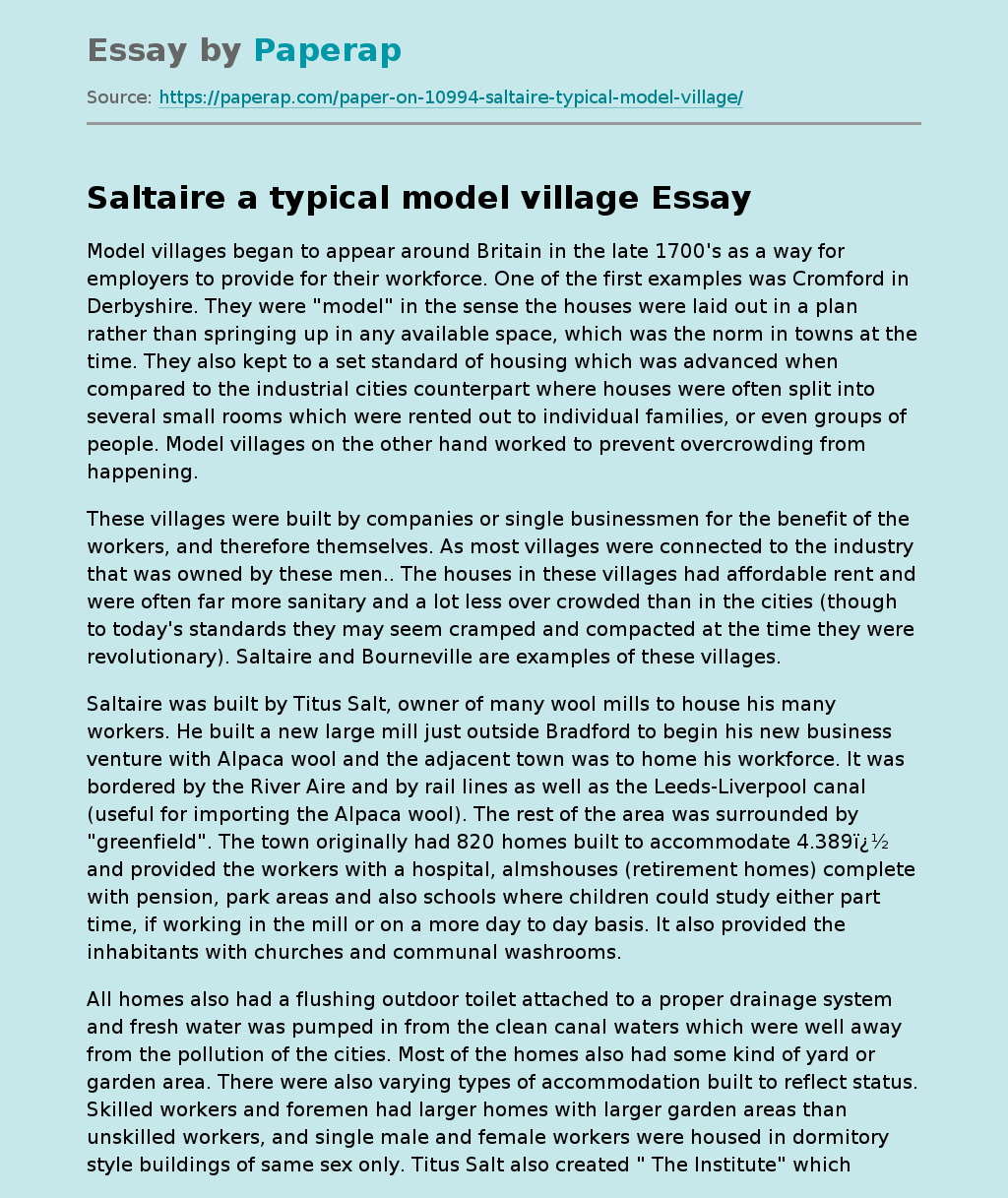Model villages began to appear around Britain in the late 1700’s as a way for employers to provide for their workforce. One of the first examples was Cromford in Derbyshire. They were “model” in the sense the houses were laid out in a plan rather than springing up in any available space, which was the norm in towns at the time. They also kept to a set standard of housing which was advanced when compared to the industrial cities counterpart where houses were often split into several small rooms which were rented out to individual families, or even groups of people.
Model villages on the other hand worked to prevent overcrowding from happening.
These villages were built by companies or single businessmen for the benefit of the workers, and therefore themselves. As most villages were connected to the industry that was owned by these men. The houses in these villages had affordable rent and were often far more sanitary and a lot less over crowded than in the cities (though to today’s standards they may seem cramped and compacted at the time they were revolutionary).
Saltaire and Bourneville are examples of these villages.
Saltaire was built by Titus Salt, owner of many wool mills to house his many workers. He built a new large mill just outside Bradford to begin his new business venture with Alpaca wool and the adjacent town was to home his workforce. It was bordered by the River Aire and by rail lines as well as the Leeds-Liverpool canal (useful for importing the Alpaca wool).
The rest of the area was surrounded by “greenfield”. The town originally had 820 homes built to accommodate 4.389� and provided the workers with a hospital, almshouses (retirement homes) complete with pension, park areas and also schools where children could study either part time, if working in the mill or on a more day to day basis. It also provided the inhabitants with churches and communal washrooms.
All homes also had a flushing outdoor toilet attached to a proper drainage system and fresh water was pumped in from the clean canal waters which were well away from the pollution of the cities. Most of the homes also had some kind of yard or garden area. There were also varying types of accommodation built to reflect status. Skilled workers and foremen had larger homes with larger garden areas than unskilled workers, and single male and female workers were housed in dormitory style buildings of same sex only. Titus Salt also created ” The Institute” which was basically a large recreational centre for his workers. It included a laboratory, library, concert hall, lecture theatre and gymnasium. A small shopping parade was also built to cater for his employees needs.
Saltaire is a typical model village because of its grid-iron pattern. The majority of the houses were built in long terraced blocks ranging in size and height to give The way in which the dwellings were arranged to maintain the welfare of the workforce, which was something that Titus Salt had always had great interest in, and yet also to give the workers a feeling of security and a better quality of life. Salts interest also lay in the fact that a healthy workforce and one that had little way to travel to work would also be more productive. He kept his workers in a good state of health with the aid of the grid-iron pattern which spaced houses out enough to prevent overcrowding and to give people their own dwellings whilst also providing them with sanitation and clean water which were almost unheard of in the city itself.
The pattern of housing also managed to give people social status with the larger homes with more gardens being closer to the mill. Titus Salt carefully managed rent to make sure that the employees could easily afford it on their wages. Another way in which he improved the lives of his workers was by the way that he created far better working conditions. This was one of the main principals behind the creation of model villages in the first case.
Saltaire was built with the workforce in mind and Titus Salt tried to provide for them in everyway possible. He intended to also build a market, hotel and abattoir. Another way in which Titus Salt shows that he looked after his workers is the “mess hall” where workers could go and have lunch provided for them. This was based just opposite the mill, however there was a direct passage to the hall covered to keep workers dry, and maybe also perhaps to stop people from delaying.
Saltaire is thought to be one of the greatest remaining examples of a model village as it has been relatively unchanged over the years. Its recent elevation to World Heritage Site is making sure that renovations are being completed and that it does not lose anymore of its originality. Although some areas no longer maintain their original purposes, for example the hospital which has now been turned into flats the basic idea behind Saltaire can still easily be seen when visited. Saltaire is now no longer home to mill operators as the mill ceased to function some years ago and now is a gallery displaying David Hockney’s work and the home of the Bradford Health Authority.
Saltaire a Typical Model Village. (2017, Dec 20). Retrieved from https://paperap.com/paper-on-10994-saltaire-typical-model-village/

